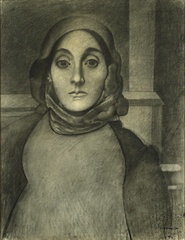Ararat by Egoyan
Our Saturday Night at the Movies was spent comfortably at home with a DVD of Atom Egoyan’s Ararat. Yes, I know it’s already two years old, it took us this long to get around to it. Wow, what a powerful film this is!
Atom Egoyan is an award-winning Canadian filmmaker of Armenian descent. This film is his most personal because it’s about his own people and their history, especially the genocide of Armenians in Turkey in 1915, never acknowledged by Turkey.
“As a Canadian-Armenian filmmaker,” says Atom Egoyan,” I had always contemplated a film about the unique history of the Armenian people. While it was tempting to consider an adaptation of one of several books, I realized it was crucial for me to root the film in the present day. In this way, I could trace the effects of this historic event on the present generation. My goal was to make a film that would allow the viewer to experience the reality of horror in a spiritual sense, and not just present the obvious results of material and physical loss.”
It is a complex many-layered story, as Egoyan’s films are, but fortunately we spent a little time researching it beforehand, especially regarding Armenia. This considerably aided our understanding and enjoyment. One of the interesting sub-plots in the film concerned Armenian artist Arshile Gorky, whose work I knew only a little, and felt compelled to learn more about later. Here is his charcoal drawing of his mother, that is similar to the paintings of her shown in the movie:

from Art Institute of Chicago collection
Ararat was filmed in Toronto and the Drumheller area of Alberta, with some footage of old churches, church art, and Mount Ararat from Turkey. The leading actors, Egoyan’s wife Arsinee Khanjian and Charles Aznavour, are Armenian. Lovely opera singer, Canadian-Armenian Isabel Bayrakdarian sang some of the hauntingly beautiful background music.
There is so much more, so if you haven’t seen it yet, I recommend it highly, especially on DVD, as it’s great in providing a lot of background to the film.
November 30, 2004 in Films, History by Marja-Leena
Rich pickings from this post – thank-you very much. As well as adding much to my historical knowledge, it made me revive some Charles Aznavour tapes, unplayed for years. Reading his biog I realise how hard he has worked for the Armenian cause. What was his role in the film?
Oh, Anna, you MUST see this film! Aznavour plays a famous Armenian director, Edward Saroyan, who is making a film about the genocide, ie. this is a film within a film. If you look at the first link in this article, the storyline is under ‘synopsis’. Under ‘ the talent’ are the actors – look for Aznavour. Like you, I’ve known his singing a long time but not his acting.
I too haven’t seen Ararat yet, although I’ve liked other films by Aton Egoyan. My mother-in-law was a survivor of the Armenian genocide, so the history means a lot to our family. Maybe I have avoided it because I feared it would be too painful.
Oh my, Beth, that IS very close to home and I too would be afraid of the pain. I think though that it might not be as painful as you think. I was a wee bit worried that it might be too violent for me, but it was ok…very moving really.
I think what I liked most about the film was that Egoyan resisted the temptation to make it “worthy” and plodding, but instead took some artistic risks.
I don’t know if “Ararat” is as successful a work as “The Sweet Hereafter” which had a spooky completeness about it. But almost any Egoyan film is worth watching, for his sharp intelligence. On a much smaller scale than “Ararat” is “Felicia’s Journey”, but like all Egoyan’s films, the acting is strong and intense.
Hello, elck, welcome to my blog!
Yes, I agree that Egoyan avoided the documentary in favour of the artistic. Maybe it’s just me, but Egoyan’s films challenge me – some things I don’t ever understand, especially his earlier work (though I haven’t seen all of his work). Yet that seems to be the nature of good and serious artwork in any medium, that we are left with some questions to ponder. What do you think?
Not just that it asks questions, but that it has an element of strangeness. Most truly powerful work is strange, I think, because life is strange.
This might be my problem with the Hollywood blockbuster, or the mass-market bestselling novel: they adhere to formula, and anything that’s strange or quirky is smoothed over. The few big-budget films that can escape that are risky, wonderful, and justly celebrated.
(A tangential thought: I’ve been trying to answer for myself why “The English Patient” was so much more successful as a movie than “Cold Mountain” was, and this is part of my answer. They are such similar films [made essentially by the same filmmakers, and on a similar scale], and yet the emotional impact of the earlier one, at least for me, far exceeds that of the latter.)
Strange or quirky – yes! Being a visual artist, I like that element along with mystery, to be in serious art work…makes one think…leaves room for interpretation by the viewer and his/her emotional reactions.
“The English Patient” certainly had all these elements. I haven’t seen “Cold Mountain” yet…your comments would suggest that it might not be worth seeing…hmm?
“Leaves room for interpretation”: I think that hits the nail on the head.
Do see “Cold Mountain” and form your own views of it. In my opinion, it was certainly better than a movie like “The Last Samurai”; not quite as good as “Master and Commander”; about the same as “Gangs of New York.”
Don’t think of all this when you finally settle down to watch it yourself!
Methinks you are quite a movie fan! Thanks for the suggestions.